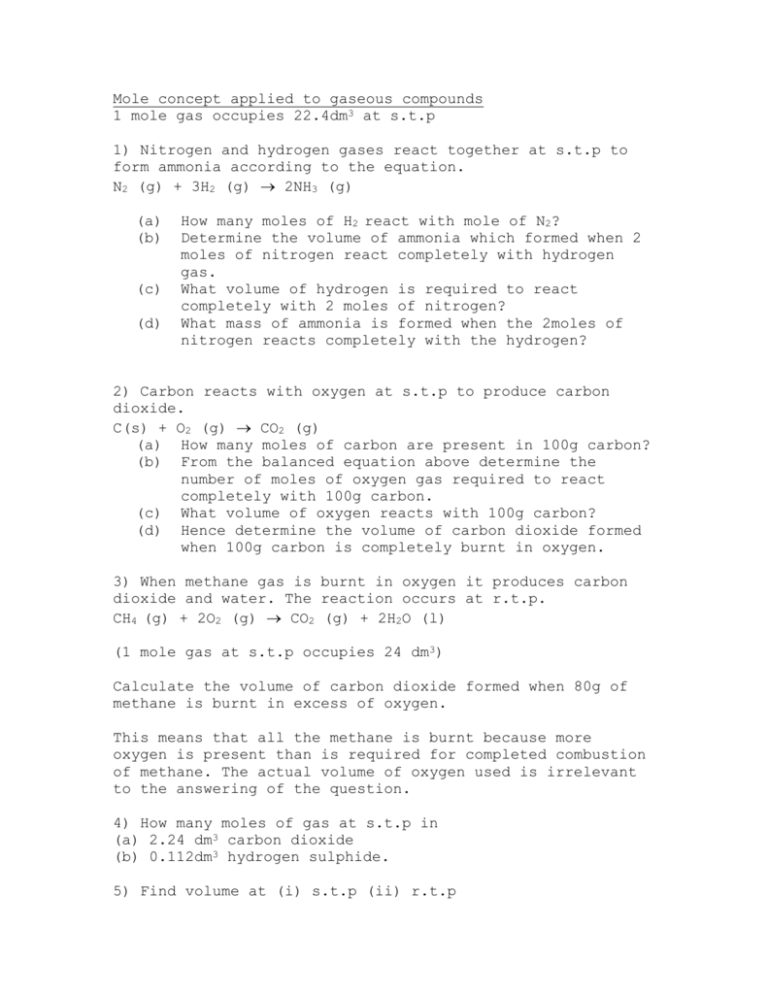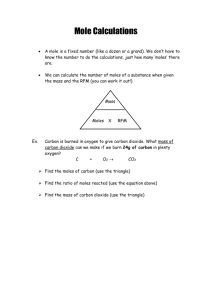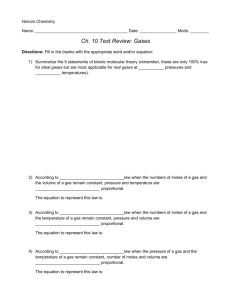Mole concept applied to gaseous compounds
advertisement

Mole concept applied to gaseous compounds 1 mole gas occupies 22.4dm3 at s.t.p 1) Nitrogen and hydrogen gases react together at s.t.p to form ammonia according to the equation. N2 (g) + 3H2 (g) 2NH3 (g) (a) (b) (c) (d) How many moles of H2 react with mole of N2? Determine the volume of ammonia which formed when 2 moles of nitrogen react completely with hydrogen gas. What volume of hydrogen is required to react completely with 2 moles of nitrogen? What mass of ammonia is formed when the 2moles of nitrogen reacts completely with the hydrogen? 2) Carbon reacts with oxygen at s.t.p to produce carbon dioxide. C(s) + O2 (g) CO2 (g) (a) How many moles of carbon are present in 100g carbon? (b) From the balanced equation above determine the number of moles of oxygen gas required to react completely with 100g carbon. (c) What volume of oxygen reacts with 100g carbon? (d) Hence determine the volume of carbon dioxide formed when 100g carbon is completely burnt in oxygen. 3) When methane gas is burnt in oxygen it produces carbon dioxide and water. The reaction occurs at r.t.p. CH4 (g) + 2O2 (g) CO2 (g) + 2H2O (l) (1 mole gas at s.t.p occupies 24 dm3) Calculate the volume of carbon dioxide formed when 80g of methane is burnt in excess of oxygen. This means that all the methane is burnt because more oxygen is present than is required for completed combustion of methane. The actual volume of oxygen used is irrelevant to the answering of the question. 4) How many moles of gas at s.t.p in (a) 2.24 dm3 carbon dioxide (b) 0.112dm3 hydrogen sulphide. 5) Find volume at (i) s.t.p (ii) r.t.p (a) 0.01 mole neon (b) 0.000002 mole carbon dioxide 6) Find the volume (i) at s.t.p (ii) r.t.p (a) 0.0028g nitrogen gas (b) 0.011g carbon dioxide 7) Nitrogen monoxide NO reacts with oxygen to give nitrogen dioxide. (a) write a balanced equation for this reaction. (b) starting with 50cm3 nitrogen monoxide, what volume of oxygen will be needed to react with it. (c) what volume of nitrogen dioxide will be formed? 8) The following reaction taken place when chlorine gas is shaken with excess ammonia solution3Cl2 (g) + 8 NH3 (aq) N2 (g) + 6NH4Cl (aq) What volume of nitrogen is formed when 72cm3 of chlorine is shaken with excess ammonia solution? 9) Calculate the volume of carbon dioxide given off, at s.t.p, when 0.9g of glucose ferments: C6H12O6 (aq) 2C2H5OH (aq) + 2CO2 (g) 10) Carbon dioxide is often made by the action of hydrochloric acid on marble chips (calcium carbonate) CaCO3 (s) + 2HCl (aq) CaCl2 (aq) + CO2 (g) + H2O (l) (a) (b) (c) (d) If the volume of a gas jar is approximately 500cm3, what volume of carbon dioxide is needed to fill six gas jars at room temperature and pressure? How many moles of carbon dioxide are needed to fill 6 gas jars? How many moles of calcium carbonate must react to give the number of moles of carbon dioxide required in (b)? What mass of calcium carbonate must react to fill 6 gas jars? 11) What volume of hydrogen is given off, at r.t.p, when 0.65g of zinc reacts with excess sulphuric acid? 12) What volume of oxygen, measured at s.t.p is given off when 0.76g of potassium nitrate is decomposed by heat according to the equation? 2KNO3 (s) 2KNO2 (s) + O2 (g)








